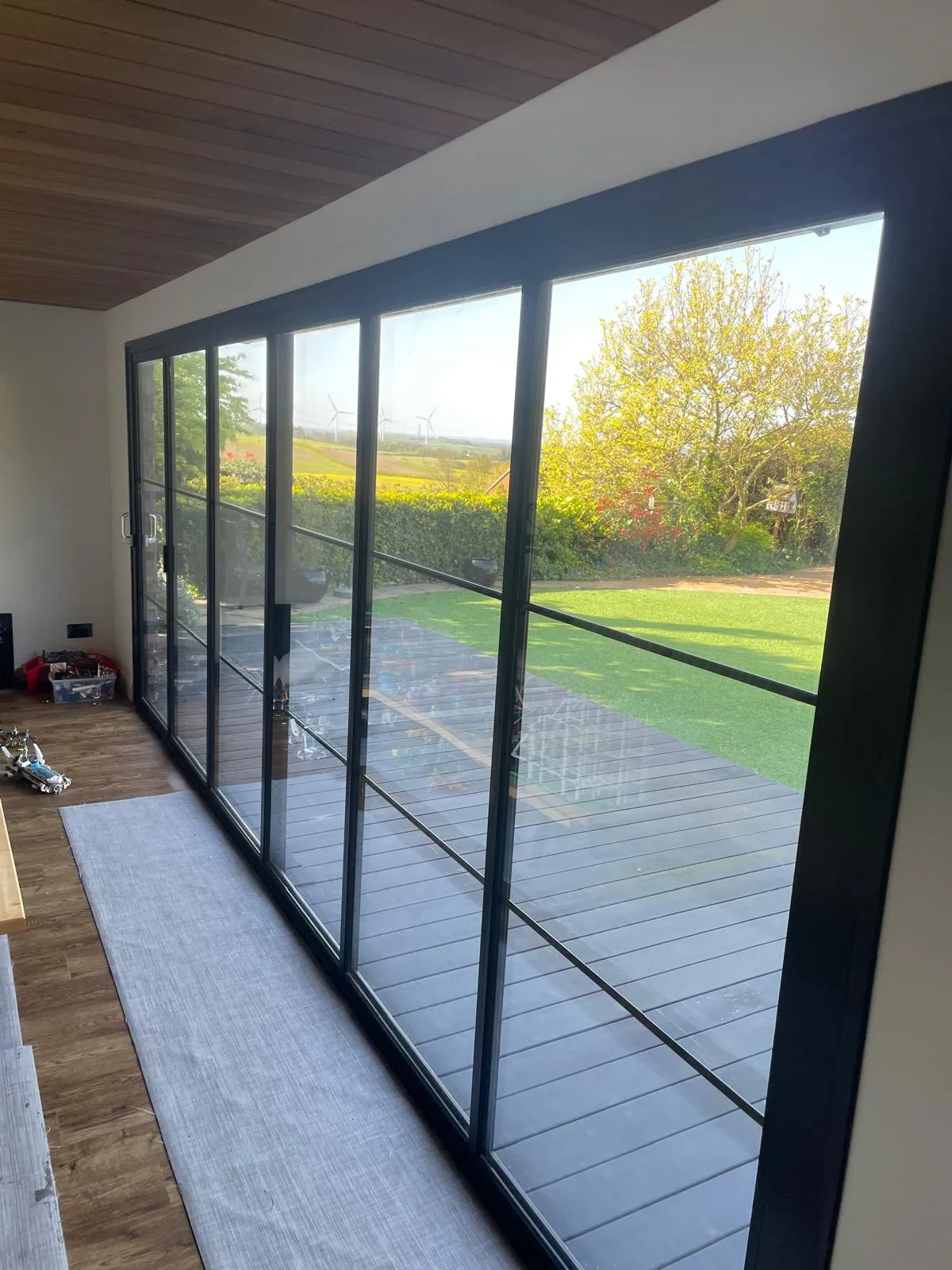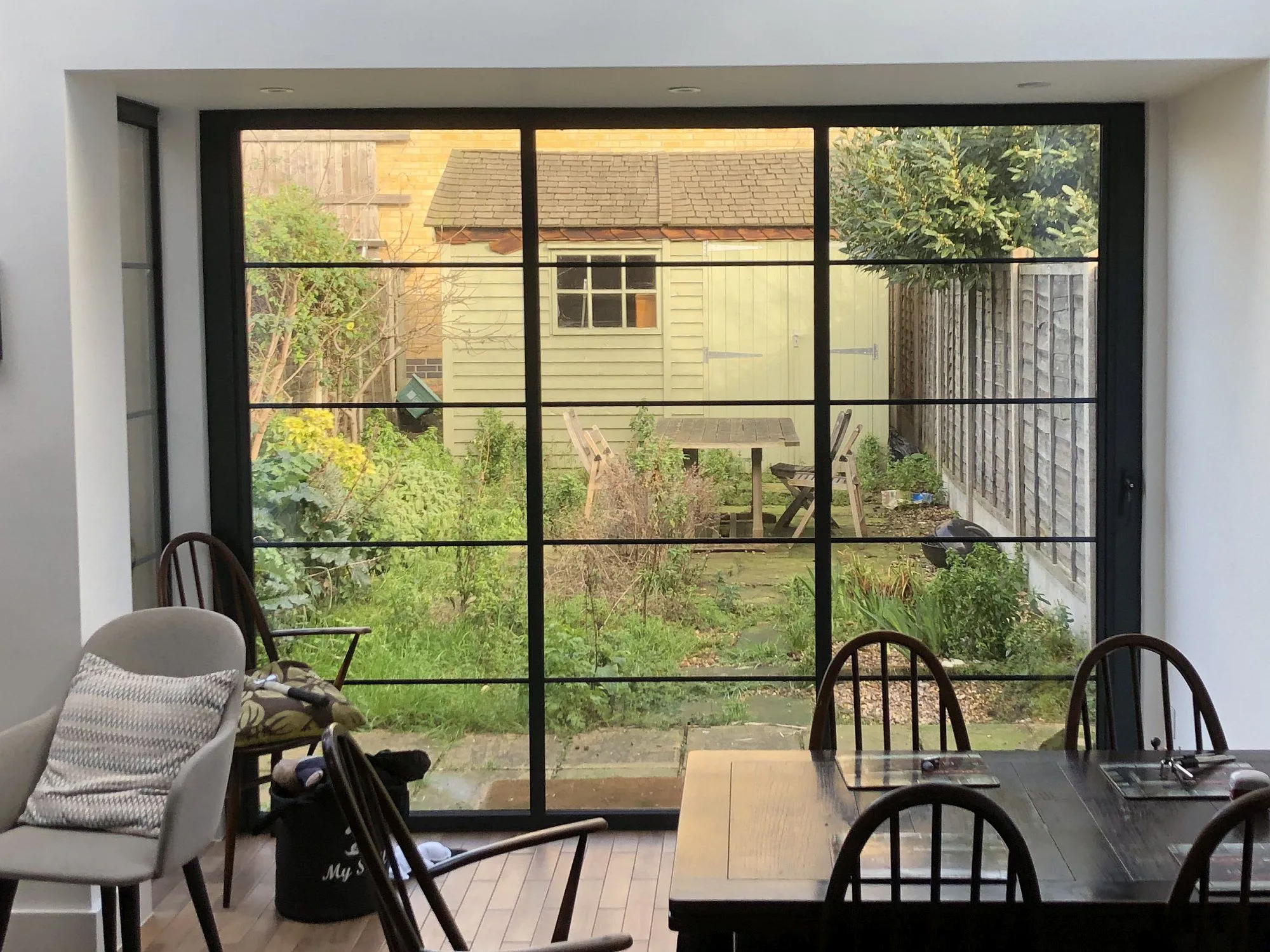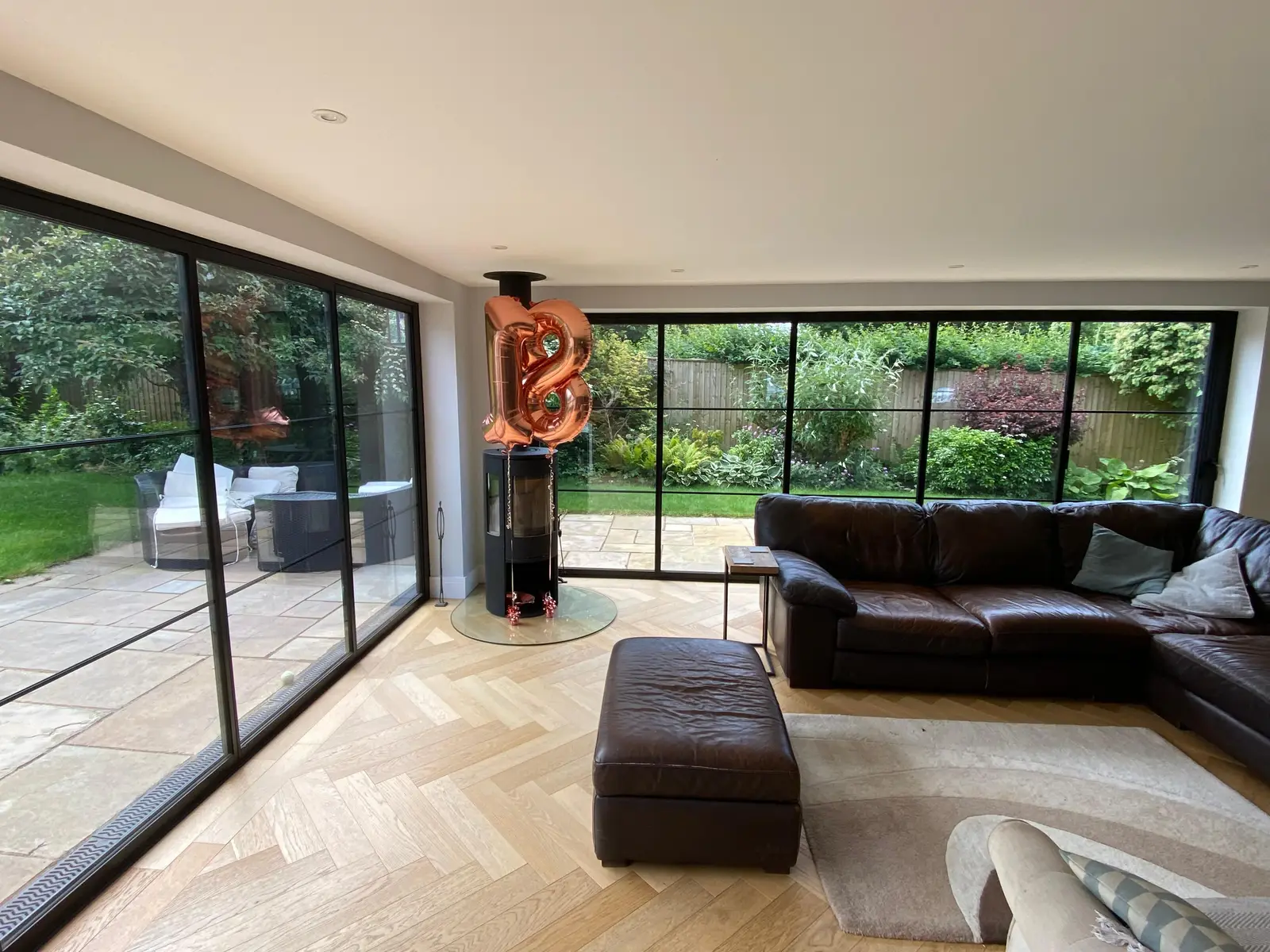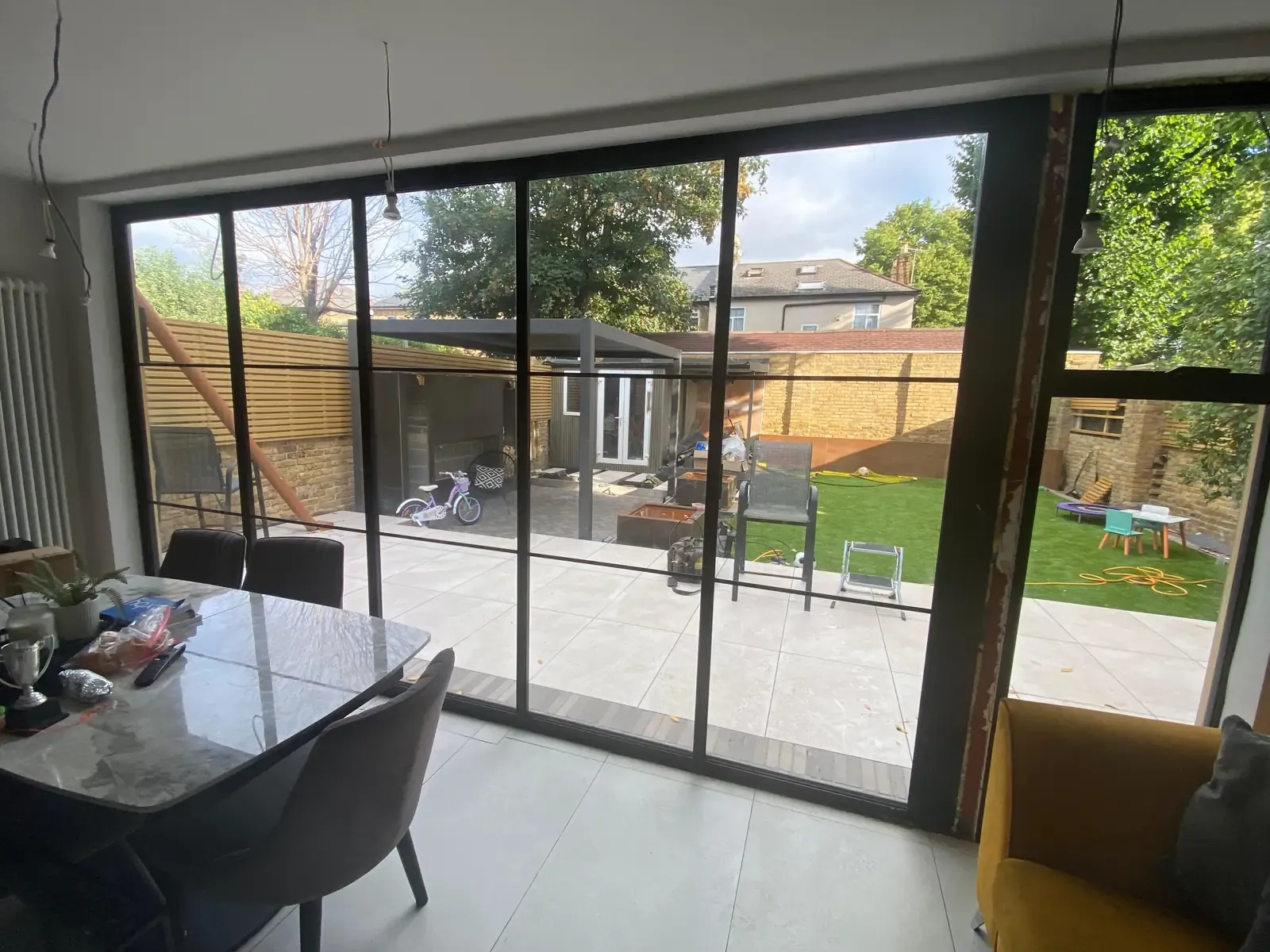A Guide to Sliding Crittall Doors (Internal and External)
Table of Contents

Introduction
The industrial charm of “crittall style” windows has found new life in contemporary British homes. Once confined to factories, warehouses, and windows in older homes, these distinctive grid-patterned designs now grace residential spaces in the form of sliding crittall doors. Their slim profiles and geometric lines offer a unique blend of vintage appeal and modern functionality.

History
From 1714 to 1830, Georgian architecture flourished, spanning the reigns of four King Georges. This style embodies symmetry and balance, drawing inspiration from ancient Greek and Roman designs. Georgian buildings captivate with their uniform facades, ornate mouldings, and sash windows. The era’s homes often boast brick exteriors complemented by white woodwork, creating an enduring aesthetic that continues to shape modern design.
Georgian windows and doors exemplify classic design principles. The windows, typically sash-style with multiple panes, combine beauty and utility. Their grid-like patterns have become synonymous with the era’s architectural style while allowing generous natural light.
Modern interpretations of Georgian elements include sliding crittall doors, which bring historical elegance to contemporary homes. These doors, featuring slim metal frames and expansive glass panes, echo the grid patterns of Georgian windows, bridging past and present.
Georgian-inspired sliding crittall style doors maintain the charm of their historical predecessors while offering modern advantages.
Anatomy of a Sliding Crittall Style Door
The striking appearance of sliding crittall doors stems from their unique construction. These doors combine the classic grid pattern of crittall windows with modern sliding mechanisms, creating a distinctive architectural feature.
Frame Materials
Traditionally, crittall style windows were crafted from hot-rolled steel, known for its strength and durability. This legacy continues with many sliding crittall style doors, which maintain the authentic look and feel of the original designs. Steel frames offer a slender profile, allowing for larger glass panels and more light transmission. They also provide excellent thermal performance when properly treated and installed.
However, aluminium has emerged as a popular alternative for crittall style sliding doors. It shares many of steel’s strengths while offering additional benefits. Aluminium frames are lighter, making them easier to operate and install. They’re also naturally resistant to corrosion, requiring less maintenance over time. This material can be powder-coated in a wide range of colours, allowing for greater customisation to suit various interior styles.
Glass Options
Single glazing, while historically accurate, is rarely used in modern installations due to its poor insulation properties. Instead, double glazing has become the standard for crittall style sliding doors, offering a good balance between thermal efficiency and cost.
Double glazing consists of two panes of glass with a gap between them, usually filled with an inert gas like argon. This configuration helps reduce heat loss and external noise, making the doors more energy-efficient and comfortable to live with.
Bar Configurations
The distinctive grid pattern of sliding crittall doors can be achieved through either external or integral bars. External bars are attached to the outside of the glass, creating a more traditional look with authentic shadow lines. They’re often preferred in heritage properties or where a more pronounced grid effect is desired. However, external bars can make cleaning more challenging and may affect the door’s thermal performance.
Integral bars, also known as Georgian bars, are sealed between the panes of double or triple glazed units. This design offers easier maintenance and better thermal efficiency. While they may lack the depth and shadow of external bars, integral bars still provide the characteristic crittall style look. They’re a popular choice for crittall sliding doors in modern homes, where practicality often takes precedence over historical accuracy.
Sliding Crittall Doors for Period Properties
Period properties often present unique challenges when it comes to home improvements. The introduction of sliding crittall doors into these spaces requires careful thought to maintain the building’s character while adding modern convenience. When done well, crittall style sliding doors can complement and even highlight the original features of older homes.

Victorian & Edwardian Homes
Victorian and Edwardian architecture often featured large windows and high ceilings, making these properties well-suited for sliding crittall doors. The slim profiles of these doors echo the delicate ironwork common in period conservatories and orangeries. In many cases, crittall sliding doors can replace existing French doors or sash windows without looking out of place.
The grid pattern of crittall style sliding doors harmonises with the geometric tiles often found in Victorian hallways. This visual connection helps the new addition feel like a natural part of the home’s design. The doors’ ability to let in ample light aligns with the Victorian penchant for bright, airy spaces, particularly in areas like sunrooms or renovated sculleries.
Edwardian homes, known for their wider frontages and emphasis on natural light, benefit from the expansive glass panels of sliding crittall doors. These doors can create a striking divide between a period drawing room and a more modern extension, acting as a visual bridge between old and new. Their industrial aesthetic also complements the Edwardian era’s move towards simpler, less ornate designs compared to their Victorian predecessors.
Crittall Sliding Doors in Contemporary Properties
The industrial roots of crittall style designs might seem at odds with modern architecture, yet sliding crittall doors have found a comfortable home in contemporary spaces. Their clean lines and minimalist aesthetic align well with current design trends, offering a unique way to define areas without compromising on light or openness.

Open-Plan Living
Open-plan layouts have dominated modern home design for years, but many homeowners now seek ways to create more defined areas within these spaces. Crittall style sliding doors offer an elegant solution to this. They can partition rooms when closed, yet maintain a sense of openness when pushed aside, allowing for flexible use of space.
In kitchen-dining areas, sliding crittall doors can separate cooking spaces from eating zones, containing cooking odours and noise without cutting off the cook from guests. The doors’ large glass panels ensure that light continues to flow throughout the space, preserving the airy feel of open-plan living. When entertaining, these doors can be slid open, reuniting the spaces for a more social atmosphere.
In home offices, sliding crittall doors provide an effective way to carve out a workspace within a larger room. When closed, they offer privacy and help to reduce distractions, creating a focused environment for work. Yet, unlike solid walls, they maintain a visual connection to the rest of the home, preventing the office from feeling isolated or claustrophobic.
Industrial Style Suburban
The raw, urban aesthetic of sliding crittall doors adds an edgy element to suburban homes. This juxtaposition of industrial style against more traditional suburban architecture creates a striking visual impact. In new-build properties, crittall sliding doors can add character and depth to otherwise plain interiors, giving them a more curated, design-led feel.
Loft conversions and attic renovations particularly benefit from crittall style sliding doors. Crittall style ultra slim sliding doors allow plenty of light into these often-dark spaces, while their industrial look complements exposed beams and brickwork. Used as room dividers or to separate en-suite bathrooms, they maintain the open feel of the loft while providing necessary privacy.
In basement conversions, sliding crittall doors can help combat the sense of being underground. Their large glass panels allow light to penetrate deeper into the space, making it feel more connected to the rest of the house. When used to divide a basement into multiple areas – such as a gym, home cinema, and playroom – they allow each space to feel distinct without losing the overall sense of openness.
Crittall sliding doors also work well in contemporary extensions. They can create a clear distinction between the original house and the new addition, acting as a visual pause between old and new. This is particularly effective when the extension has a different architectural style from the main house, as the doors provide a transition point between the two aesthetics.
The versatility of crittall style sliding doors allows them to adapt to various contemporary design schemes. While black frames are classic, other finishes can suit different styles. White frames can create a softer, more Scandinavian feel, while bronze or brass finishes add warmth to minimalist interiors. The ability to customise the grid pattern also allows these doors to complement a range of architectural styles, from sleek modernist designs to more eclectic, bohemian interiors.
External Sliding Crittall Doors

Patio Doors with a Twist
Traditional patio external doors often lack character, but crittall style sliding doors offer a compelling alternative. Their distinctive grid pattern adds visual interest to what might otherwise be a plain glass expanse. When closed, these doors frame the view of the garden or patio, turning it into a living artwork that changes with the seasons.
The slim frames of crittall sliding doors allow for larger glass panels than many standard patio doors. This increased glass area not only lets in more light but also provides wider views of the outdoors. In smaller gardens, this can create the illusion of a larger area, making the exterior feel more spacious and inviting.
Black sliding doors in the crittall style are generally the most popular, but many other colours may also be available to choose from.
During warmer months, these doors truly come into their own. When fully opened, they create a wide, unobstructed passage between indoor and outdoor areas. This makes them ideal for summer entertaining, allowing guests to move freely between the house and garden. The doors’ ability to stack or slide to one side means they don’t eat into valuable patio space when open.
Crittall style sliding doors also offer practical benefits as exterior doors. Their sturdy construction and secure locking mechanisms provide good security, while modern glazing options ensure excellent thermal performance. This means homeowners can enjoy the aesthetic benefits of these doors without compromising on comfort or energy efficiency.
Greenhouse and Conservatories
The heritage of crittall style windows in greenhouses and conservatories makes sliding crittall doors a natural fit for these structures. In modern interpretations of the classic conservatory, these doors can form entire walls, creating a space that feels connected to the garden even when closed. The grid pattern of the doors echoes traditional greenhouse designs, adding authenticity to new builds inspired by Victorian garden architecture.
For those with a greenhouse, crittall sliding doors can provide a stylish and practical entrance. They allow for easy movement of plants and equipment while maintaining the period-appropriate look. The doors’ ability to open wide is particularly useful during the busy planting and harvesting seasons.
In more contemporary garden room designs, sliding crittall doors can be used to create flexible spaces that serve multiple purposes. A home office or studio that opens fully to the garden can double as a summer entertaining space. The doors allow these rooms to adapt to different uses and seasons, making them valuable additions to the home.
The use of crittall style sliding doors in outdoor structures isn’t limited to fully enclosed spaces. They can also be used to create sheltered seating areas or outdoor kitchens that offer protection from the elements without feeling completely cut off from the garden. Partial walls of crittall doors can provide windbreaks and define spaces within larger patios or decks.
When selecting sliding crittall doors for exterior use, it’s important to choose models specifically designed for outdoor applications. These will have appropriate weather sealing and drainage features to ensure they remain watertight and durable in all conditions. Powder-coated finishes are often recommended for exterior doors, as they provide excellent resistance to weathering and can be specified in a wide range of colours to suit the property’s exterior scheme.
Crittall Style Sliding Internal Doors
Furniture Pairings
The strong lines and industrial aesthetic of crittall style internal sliding doors pair well with a variety of furniture styles. Mid-century modern pieces, with their clean lines and organic forms, complement the geometric pattern of the doors without competing for attention. A classic Eames lounge chair or a sleek Danish sideboard can create an interesting contrast with the doors’ grid-like structure.
For a more eclectic look, vintage industrial furniture echoes the doors’ heritage. Think repurposed factory carts as coffee tables or old drafting stools as bar seating. These pieces reinforce the industrial theme without overwhelming the space. Softer, more traditional furniture can also work well, providing a counterpoint to the doors’ stark lines. A plush Chesterfield sofa or a wingback chair can add a touch of comfort and luxury to balance the industrial edge of crittall style sliding doors.
When it comes to dining areas, consider tables with metal bases or accents to tie in with the doors’ framework. Glass-topped tables can create a sense of continuity with the doors’ glazing, making the space feel larger and more open. Chairs with slim metal frames echo the doors’ structure without adding visual weight to the room.
Color Schemes
While black is the classic choice for sliding internal crittall doors, exploring other colour options can yield stunning results. Deep navy or charcoal frames can provide a softer alternative to black, adding depth without the starkness. These darker hues work well in rooms with a cooler colour palette, complementing blues, greys, and whites.
For a warmer look, consider bronze or copper-toned frames. These rich metallics add warmth and luxury to a space, pairing beautifully with earthy colours and natural materials like wood and leather. In rooms with a neutral palette, these warmer tones can provide a subtle point of interest without overpowering the overall design.
White or light grey crittall style sliding doors offer a fresh, contemporary take on the classic design. These lighter colours can help small spaces feel more open and airy. They’re particularly effective in Scandinavian-inspired interiors, where light colours and natural materials dominate.
When selecting wall colours to complement interior sliding crittall doors, consider the overall effect you want to achieve. Dark walls can make the doors pop, creating a dramatic contrast. Lighter walls allow the doors to stand out as an architectural feature without dominating the space. For a cohesive look, choose a wall colour that’s a few shades lighter or darker than the door frames.
Lighting
Consider installing LED strips along the top or bottom of the door frames to create a subtle glow that outlines the doors’ structure. This not only looks impressive but can also serve as gentle ambient lighting for the room. Pendant lights hung near the doors can cast interesting shadows through the glass panels, adding depth and interest to the space.
For rooms divided by crittall style sliding doors, coordinating lighting on both sides helps maintain a sense of continuity. Wall sconces or picture lights mounted on either side of the doors can draw attention to their architectural qualities while providing useful task lighting.
When the doors separate spaces with different functions, such as a living room and a home office, varying the lighting in each area can help define the spaces. Softer, warmer lighting in the living area contrasted with brighter, cooler light in the work space can create distinct atmospheres while still allowing the areas to feel connected through the glass panels of the sliding crittall doors.
Sliding Crittall Doors FAQ
What are sliding crittall style doors?
Sliding crittall style doors are a modern adaptation of traditional heritage doors, featuring a distinctive grid pattern of slim metal frames. These glass doors combine the industrial aesthetic of original Georgian windows with the functionality of sliding mechanisms.
How do crittall style doors differ from regular doors?
Crittall style doors are characterised by their slim metal frames and grid-like design, which sets them apart from standard doors. They typically feature larger glass panels divided by metal bars, creating a striking geometric pattern. This unique aesthetic allows them to serve as both functional doors and architectural features, adding visual interest to any space.
Can sliding crittall doors be used internally?
Yes, sliding interior doors in the crittall style are increasingly popular for internal use. They’re an excellent choice for dividing living spaces while maintaining an open feel, often used between kitchens and dining rooms or to create home offices. Their sleek design and large glass panels allow light to flow between spaces, making them ideal for smaller homes or areas where natural light is at a premium.
How wide can sliding crittall style doors be?
Large sliding doors in the crittall style can span impressive widths, with some manufacturers offering panels up to 1.5 metres wide. Multiple panels can be combined to create openings of 6 metres or more, depending on the specific system and installation requirements. It’s important to consider factors such as the building’s structure and the weight of the doors when planning for very wide installations.
Are crittall sliding doors suitable for commercial buildings?
Crittall style sliding doors are indeed suitable for commercial properties, offering a blend of functionality and industrial chic that works well in modern office spaces, restaurants, and retail environments. Their ability to create flexible, multi-use areas is particularly valuable in commercial settings.
We’d Love to Help You
Vision Glass Doors is a designer, manufacturer, and installer of premium door systems. We are a family run business with over 20 years’ experience and 5,000 installations across the UK.
Our leading range of door systems include Ultra Slim – Slide and Turn Doors, Slimline Sliding Patio Doors and Frameless Glass Doors. Suitable for various internal and external applications, they are applicable to residential and commercial projects.
Click Quick Quote Online for a free quotation within 24 hours. Alternatively, call or email us on 01582 492730 or at info@visionglassdoors.co.uk.

